-
Paper Information
- Paper Submission
-
Journal Information
- About This Journal
- Editorial Board
- Current Issue
- Archive
- Author Guidelines
- Contact Us
International Journal of Information Science
p-ISSN: 2163-1921 e-ISSN: 2163-193X
2020; 10(1): 1-8
doi:10.5923/j.ijis.20201001.01

An Assessment of Child Online Risks and Effects in Zambia: A Remedy for Child Online Protection
1Department of Electrical and Electronic Engineering, University of Zambia, Lusaka, Zambia
2Assistant Dean, Technical School of Engineering, University of Zambia, Great East Road Campus, Lusaka, Zambia
Correspondence to: Gezile Zulu, Department of Electrical and Electronic Engineering, University of Zambia, Lusaka, Zambia.
| Email: |  |
Copyright © 2020 The Author(s). Published by Scientific & Academic Publishing.
This work is licensed under the Creative Commons Attribution International License (CC BY).
http://creativecommons.org/licenses/by/4.0/

Due to the increase in internet usage by children over the years, countries in Africa have embarked on strengthening their policies through the integration of child online protection measures aimed at protecting children from internet risks and threats. Evidence suggested in studies concerning internet addiction disorder shows that overuse of the Internet can genuinely restrain children especially teenagers' experiences in life, their performance academically, overall happiness, and physiological well-being. Further, literature also suggests a relationship between internet use in adolescence and other variables such as depression, social isolation, distorted sense of reality, and access to uncensored material (pornography), eating disorders and online harassment among many others. Nevertheless, much remains uncertain as to whether such assertions can be generalized to Zambia although it is no secret internet usage among our children is only exhibiting an increasing trend owing to the continued access to portable internet platforms such as smart mobile phones. Findings from the research survey indicate that the majority 96% of the 105 respondents say that hate speech and social media addiction are the most prominent internet risks children are likely to encounter, 92% say it is cyberbullying, 89% say it is sexting and posting of nude photos and 89% say it is fake news among other risks. Further findings indicate that the majority 57% say that depression is the prominent effect of internet risks among children, 53% say it is low self-esteem, 52% say it is deteriorating social behavior and rudeness and 49% say it is loss of concentration on education. Very few comprehensive research have been done on the status of child online protection in Zambia from the perspectives of ISPs, MNOs and the regulating institution of telecommunications ZICTA. The study in addressing the literature gap is crucial for policy makers in the Ministry of Transport and Communication as it will act as a catalyst for refinement and concession of policies to bring into inclusion the risks that children are exposed to on the internet thereby play a role in protecting the future leaders of tomorrow.
Keywords: Child Online Protection (COP), Online risks, Effects, Measures
Cite this paper: Gezile Zulu, Simon Tembo, An Assessment of Child Online Risks and Effects in Zambia: A Remedy for Child Online Protection, International Journal of Information Science, Vol. 10 No. 1, 2020, pp. 1-8. doi: 10.5923/j.ijis.20201001.01.
Article Outline
1. Introduction
- The increasing availability of internet in Zambia made available by MNOs and Internet service providers ISPs has prompted the unprecedented rise in usage across the country for various reasons largely social, business, academic and research respectively [5]. Whereas discourse may rise as to whether the internet has brought more harm than good, suffice to note that this paper focuses on exposing the risks that internet brings to the children users. According to Article 55 of the Constitution of Zambia, a child is defined as anyone below the age of 18 years. This until recently was not the definition as prior to the amendment of Zambia’s current Constitution in 2013, the previous Constitution guaranteed rights to all persons including children, it did not define the age of a child although it did however, in Article 24(4), define a “young person” as any person under the age of 15 years. The current definition of child is reflective of Article 1 of the CRC which also defines a child as every human being below the age of 18. Due to the increase in internet usage by children over the years, Zambia has since embarked on strengthening its policies through the integration of child online protection measures aimed at protecting children from internet risks. These risks associated with the internet can be categorized into: Internet Technology risks; Content risks – illegal activities, harmful content, harmful advice; Contact risks – cyberbullying, online harassment, content sharing, online dating; Commercial related risks –online marketing, age restricted products, online scams; and Information privacy and Security risks – revelation of personal data, identity theft, sharing passwords [14].On this backdrop, Zambia has been facing huge challenges in protecting vulnerable children from various abuses on the internet such as cyberbullying, child pornography, paedophilia, sexting, Satanism and other evil vices on the internet. The preceding challenges in establishing a budget line in each key line ministry and in implementing a national child online protection policy and implementation plan that would enhance coordinated response to child abuse through the internet prompted key stakeholders to provide empirical evidence supporting the need for policy development on COP. ZICTA in collaboration with Central Statistics Office (CSO) undertook a national ICT survey in 2013 and 2015 on online risks and illicit content which reviewed findings that emphasized the need for a national policy on COP. According to the Annual Human Capacity building workshop on Child online safety held in Malawi, 18-20 July 2016, ZICTA demonstrated that a national policy on COP was imperative. There is limited research on COP to compliment efforts by ZICTA to clarify the trend of risks and their effect on children as well as a trend on the usage of the internet by children, safety measures implemented by guardians and knowledge on the importance of COP prevalent today. The study will fill this gap by seeking to determine prominent risks that children are exposed to on the internet in Zambia and their effect, to determine the challenges affecting the implementation of COP in various organizations and government agencies and to determine measures put in place by various organizations and government agencies in the Tele-communications sector to curb child online abuse.
2. Child Online Protection
2.1. The Internet
- The internet as a technological advancement has brought numerous benefits and challenges on how information is shared from one place to another among people from various backgrounds in different localities across the globe. By definition, DiMaggio et al (2001) opine that the internet is an electronic network of networks that links people and information through computers and other digital devices allowing person-to-person communication and information retrieval. The number of people using the internet has been increasing since its introduction and there has been astronomical advancements in user interface technology of the internet with attributes of easy portability and faster processing power as well as real time conferencing for people in different locations [3].However, to be able to tell exactly how the internet alters individual’s lives is quite an elusive endeavor as Kubey (2000) in his argument asserts that despite the internet been a revolutionary tool that brought with it numerous benefits ranging from business to social inter-linkages, as a collective body, people must be aware that it can as well become a source of harm when it is abused. [18] The distinctive characteristics of the Internet as a new medium for communication in comparison to old media notably television, radio and newspaper lies in its active and interactive paradigm which means that two people can exchange information in real time as both users and it transcends time and space by bring two people in distant places together under one umbrella as Walcott (1999) consents that children are the most active users of the internet sending pictures to each other while on holidays and camping trips for instance.
2.1.1. Internet and Children
- With the increasing perception that the internet is constantly an active and interactive medium, children have now become active users as well unlike they were perceived in recent years as only seekers of information when on the internet (Tapscott 1998b). The modern thought therefor entails that children are now able to enjoy the features that are on the internet. Today, children can shop online, discuss various subjects, play online games, criticize what is not appealing, confront each other and make inquiries on various subjects [10]. Although Demner, (2001) insists that the internet is in fact an educational and developmental tool for parents and teachers as well as children as it provides a platform on which children can access information for their home works and assignments, Turow (1999) in his research argued that the content on the internet is a source of concern as children can access harmful information without the mediation of guardians in the context of home or school library. Nie and Erbring (2000) reported that a huge number of children use the internet to get into chat rooms with strangers which made their parents nervous about their children’s internet use. Chat rooms are an internet hazard as they promote stranger danger. Contacting strangers and exchange personal details makes children vulnerable and exposes them to various risks such as sexual abuse and sexual trafficking [20]. Another source of concern according Nie and Erbring (2000) is the displacement effect that the internet may have on the buying and consuming behavior of children. The internet is infested with commercial ads that constantly pop-up every now and then while online. These may interfere with children’s buying and consuming behavior as a result of the information overload from these ads. Oravec, (2000) observed that children with little internet experience are the ones who are likely to be affected.Flanagin and Metzger (2000) questioned the credibility of the internet as a medium of information exchange. It was apparent to them that most people seemed to believe that the information on the internet was more reliable and accurate as compared to other mediums. [21] This is a concern among children who happen to depend on the internet for answers to most of their questions. Because children are not fully developed in the reasoning and judgment, they are victims of misinformation and fake news. By extension of this, they conform to hate speech which they see on the internet and to them it is a socially accepted norm because it is everywhere on the internet [23]. Thus, whether a high level of Internet usage is related to the level of credibility of the Internet is an interesting question to investigate.
2.2. Child Online Protection in Selected Countries in Africa
- In terms of mobile and internet penetration in Africa, Kenya is leading. According to the Communications Authority of Kenya, mobile penetration stood at 88% in 2017, while internet penetration at 74% – 9 out of 10 Kenyans have a mobile device and 7 out of 10 can access the internet. There is a digital divide in Kenya with regards to internet access among children as the most common internet access point is through mobile devices which children do not own. Data from Kids Comp Camp survey 2014 to 2016 showed that less than 2% of the 6,300 children had accessed the internet in rural areas and that less than 25% had accessed the internet in urban areas. Another survey by Youth Alive Kenya, commissioned by UNICEF in 2013 on the use of digital media among adolescents in Kenya showed that 74% aged 12–17 access mobile phones and 42% access the internet at least twice a week. Protecting children in Kenya from online threats follows the Data Protection Bill 2013 which sets to protect the right of every person not to have ‘information relating to their family or private affairs unnecessarily required or revealed’, and ‘the privacy of their communications infringed.’ The Kenya Information and Communications Act currently gives mandate to the Communications Authority to ensure all consumers, including children, are protected.In 2015, through a campaign called ‘Be the Cop’, the Communications Authority of Kenya sought to provide consumers, especially children and young people, with information and skills to practice safe internet use, to minimize their exposure to risks, preventing them from being victims of online crime and fraud. The implementation of COP commenced in 2018.Google Kenya also launched a children online safety initiative to promote the responsible and positive use of the internet among young learners. In Ghana however, the Ministry of Gender, Children and Social Protection through its position paper on children’s online safety concerns noted that institutional frameworks or policies intended to safeguard children in cyberspace remain obscure. No provisions for the protection of children online are visible in the Information and Communications Technology for Accelerated Development (ICT4AD) Policy. The sector regulator, the National Communications Authority (NCA), has also not developed any specific guideline or policy to guide industry players and users on COP issues [24]. The resultant effect of the lack of policy on COP is the fact that there is no clear guideline on how issues of online abuses or violations against children are to be addressed. So far, reported cases of online abuses against children have been interpreted as isolated cases of child abuse or young people’s non-adherence to rules. Even though Ghana has ratified the UN Convention on the Right of the Child, and given meaning to the Convention by enacting the Children Act 1998, neither the Act nor the recently-introduced Child and Family Welfare Policy has online safety/protection considerations [24]. What is currently available is the Ministry of Communications’ National Cyber Security Policy and Strategy Final Draft document (as at July 23, 2015) which makes the following provision in relation to COP: Child Online Protection Policy measures will be implemented through multi-stakeholder working by government, industry, civil society, and relevant international child online protection agencies. Government will encourage dialogue at national and local levels to engage all concerned and create awareness of the possibilities and dangers of the Internet.
2.3. Child Online Protection in Zambia
- Zambia as a country currently has no Child Online Protection framework. As such, the Zambia Information and Communications Technology Authority (ZICTA) acting with other stakeholders and COP experts formulated a COP framework for Zambia addressing issues of cyber security in a coordinated and synergistic approach in order to protect children and youths from cybercrime as they go about their Online activities. The Zambia Information and Communications Technology Authority (ZICTA) is an ICT Regulatory body responsible for regulating the ICT Sector in Zambia. It falls under the Ministry of Transport, Works, Supply and Communications and derives its mandate from the three Acts; the Postal Services Act No. 22 of 2009; Electronic Communications and Transactions Act No.21 and the Information and Communications Technologies (ICT) Act No.15 of 2009, to regulate ICT'S, postal and courier services in Zambia.In response to the recommendations of the conference held in 2014 on dates between 26 to 28 march 2014, the ICT sector performance report 2015 suggested that the mobile telecommunications had 11.6 million subscribers representing 74% penetration rate, the number of mobile data users 6.1 million 39% penetration rate, PSTN number of connections 116, 165 representing 0.7% penetration rate and 38, 316 for Internet Service Providers (ISP) penetration rate of 0.3%. Prior to these findings, ITU launched the Child Online Protection (COP) Initiative in 2008 to ensure a safe and secure online experience for children everywhere. In line with ITU COP Strategy, COP Zambia aims to address COP through the proposed 5 Pillars relating to legal, technical, organizational issues as well as capacity building and international co-operation. In order to develop a comprehensive strategy based on empirical data, ZICTA in collaboration with Central Statistics Office undertook a national ICT. Findings showed that on the item- Access to Mobile Phones, around 64.5 percent of the households in the country have access to a mobile phone determined by at least one member of the household owning a mobile phone, 51 percent of people aged above 10 years in Zambia are active users of mobile phones, and about 71 percent of individuals that own smartphones use the devices to access Over The Top (OTT) applications like WhatsApp, Viber, Facebook, Skype and Twitter for communication using instant messaging or voice calling. The survey also reviewed that percentage of Households that monitor internet usage was 31% and 23% in the years 2013 and 2015 respectively and the percentage of Households that have mitigation measures to protect household members from online hazards where 14% and 36% in the years 2013 and 2015 respectively.In order to address the issues highlighted in the survey, the line ministry, ZICTA (ITU-IMPACT), organized a Child Online Protection (COP) Framework Workshop in 2013 whose primary objective was to develop a sustainable Action Plan to be implemented in the country with the Ministry of General Education being key in the implementation process. The outcome of this workshop paved the way in the developing process of a national policy on child online protection as well as a strategy integrating all the relevant stakeholders.
3. Methodology
- The study used a survey design. The study opted to use survey design as surveys are capable of obtaining information from large samples of the population. They are also well suited to gathering demographic data that describe the composition of the sample (McIntyre, 1999, p. 74). Surveys are inclusive in the types and number of variables that can be studied, require minimal investment to develop and administer, and are relatively easy for making generalizations (Bell, 1996, p. 68). A questionnaire was developed and distributed to 105 respondents comprising of officials from selected ISPs, MNOs and ZICTA to collect primary data while government reports and policy documents, international electronic journals as well as electronic books on child online protection were main sources of secondary data. Non-probability sampling technique specifically the purposive sampling approach was used to conveniently identify ISPs and MNOs on the basis of proximity from the researcher’s institution of learning while simple random sampling was used to select respondents from the various organizations. Data analysis uses descriptive and content approaches.
4. Findings
- The findings are as shown below. However, to avoid unnecessarily lengthening the article, some demographics have been omitted as well as non-prominent online risks and effects.
4.1. Findings on Prominent Online Risks
- Figure 1 shows that out of the 105 respondents, the majority 65% were from ZICTA, 15% were from the ISPs and 20% where from MNOs.
 | Figure 1. Respondents by organization |
 | Figure 2. Cyberbullying |
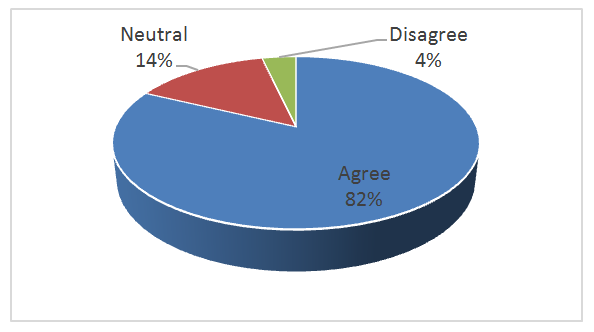 | Figure 3. Child pornography |
 | Figure 4. Emotional abuse |
 | Figure 5. Sexting |
 | Figure 6. Child gaming |
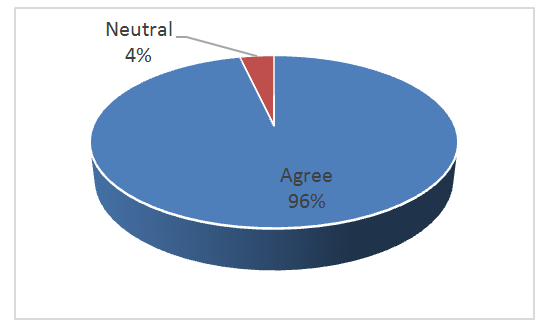 | Figure 7. Social media addiction |
 | Figure 8. Hate speech |
 | Figure 9. Fake news |
4.2. Findings on Prominent Effects of Online Risks
- Figure 10 shows that the majority 57% strongly agreed that depression is a prominent effect of child online risk while 24% agreed. 15% were neutral while the least 4% disagreed. Depression (major depressive disorder) is a common and serious medical illness that negatively affects how a person feels, the way they think and how they act.
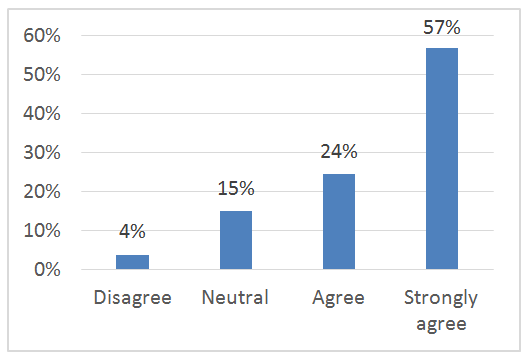 | Figure 10. Depression |
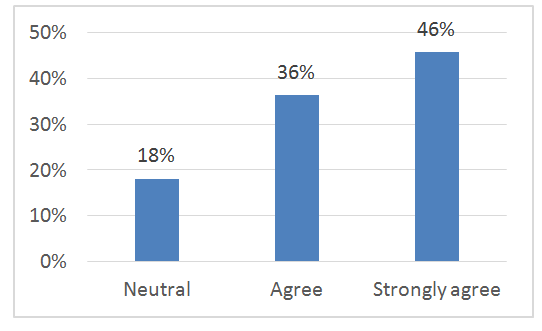 | Figure 11. Self-harm |
 | Figure 12. Rudeness |
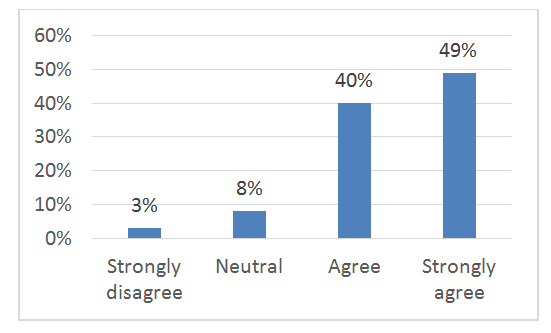 | Figure 13. Loss of concentration on education |
 | Figure 14. Deteriorating social behavior |
 | Figure 15. Low self-esteem |
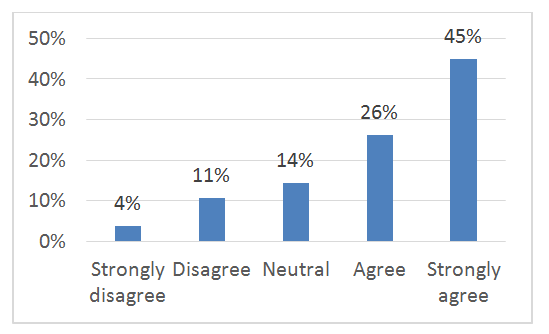 | Figure 16. Drug abuse and alcoholism |
5. Conclusions
- The study established that the most prominent risks that children in Zambia are exposed to include: fake news; hate speech; cyberbullying; sexting/posting nude photos and social media addiction. The study established also that the most common effects of these internet risks on children are: low self-esteem/loss of confidence; deteriorating social behavior; self-harm; depression; and drug abuse/alcoholism.Under policy the study established that organizations have Acceptable Usage Policy (AUP) or alternatively Service License Agreement (SLA) in place with regard to safe usage of the internet for children such that in an event of a breach, sanctions can be imposed. In addition, the study established that filters, e-safety firewalls and other software are tools that organizations use to monitor child internet abuse. In relation to handling procedure of cases of child online abuse, the study established that organizations mostly use filters and AUPs. However, the study established that the reporting mechanism for child online abuse cases used by the organizations is mainly through Standard Operating Procedure which is done through engaging into telephone conference with the authorized call centers and physically visiting the premises of the authorized institutions. The study established that the main functions of COP leading institution are: providing tools for detecting and combating child online abuse; creating awareness of COP through training programmes; expanding consumer protection guidelines to include COP; and embed UNICEF guidelines for internet safety into consumer protection guidelines.The study established that the challenges affecting COP are: inadequate financial resources to implement COP projects; inconsistency in conducting training programmes; inadequacy in the human resource development area; inadequate material resources for COP implementation projects; and lack of support from top management to advocate for prompt implementation of COP projects.The study further established that the measures in curbing child online abuse are: building capacity in COP training programmes/workshops; increase sensitization of ICT, human resource, marketing, legal officers, customer services and top management staff on COP and e-safety; strengthening ties with the law enforcement agencies such as the police and drug enforcement agency; strengthening the legal framework and policy to incorporate COP; use of child emergency lines; and children counselling.In conclusion, the study has demonstrated that child online protection is a crucial subject that has continued to remain quiet in the politics of modern day social and economic discourse. In light of the prominent risks highlighted, the Government through its agencies should spark the necessary conversation on COP to quickly address these gaps in terms of policy formulation. The study has outlined a number of measures that can be taken in ensuring that the child is protected as they browse the internet. It is cardinal that as a country, the necessary steps are taken in addressing COP as a collective body amidst the increasing access to the internet among children.
AKNOWLEDGEMENTS
- Firstly appreciations go to the highest God who continued to give me strength in spite of the many challenges I was facing at work and family. His strength has been a beacon of hope throughout this endeavor.I would like to express my heartfelt gratitude to Dr Simone Tembo whose guidance during this endeavor was timely and positive. His patience and encouragements are befitting of an educator of his stature.Secondly, deepest appreciations go to my family for their encouragements during this tedious academic pursuit. They were robbed of my time intended to be spent with them but still encouraged me.To my colleagues among them Eddie Liywalii and Mubanga Kanyanta, your timely support in organizing and structuring this work is intended appreciated.
 Abstract
Abstract Reference
Reference Full-Text PDF
Full-Text PDF Full-text HTML
Full-text HTML